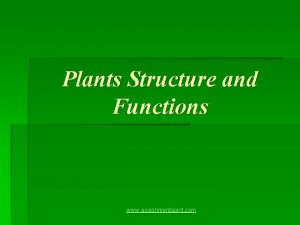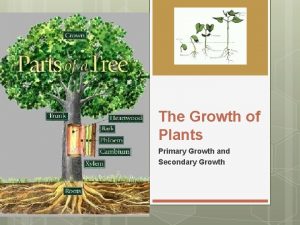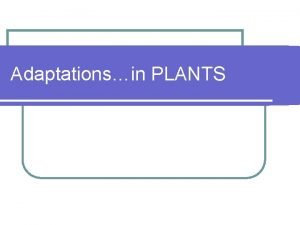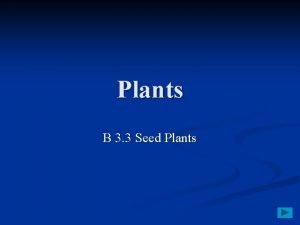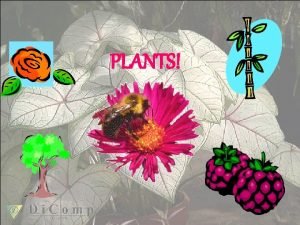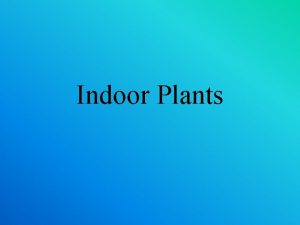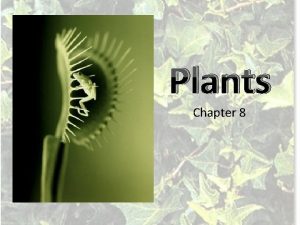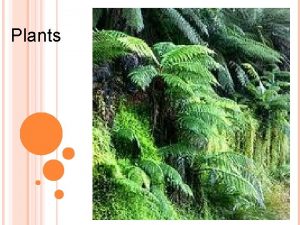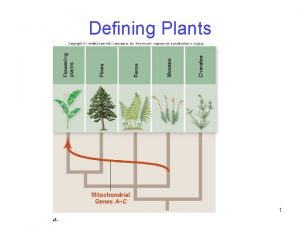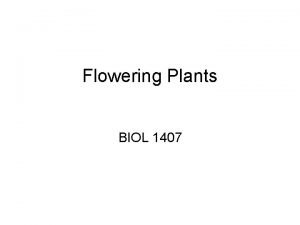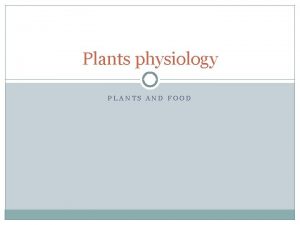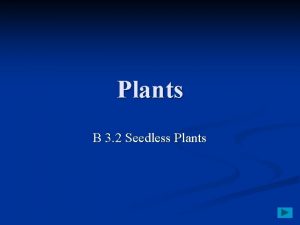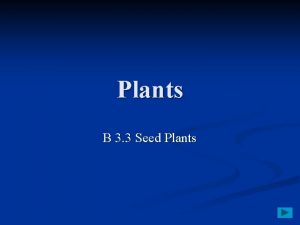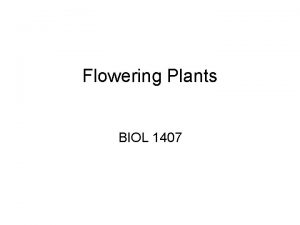Secondary Growth of Plants www assignmentpoint com Secondary























- Slides: 23

Secondary Growth of Plants www. assignmentpoint. com

Secondary growth of the stem • Increase in thickness of the stem is called secondary growth or secondary thickness. Secondary thickness takes place in 3 steps: - Formation of secondary xylem and secondary phloem - Formation of cork - Formation of lenticels www. assignmentpoint. com

Formation of secondary xylem and secondary phloem • Parenchyma cells between the vascular bundles begin to divide. This with vascular cambium forms a complete ring of cambium • Entire cambium divides to form secondary xylem on the inside and secondary phloem on the outside. • Every year a new ring of secondary xylem is formed. These are called the annual rings. (can tell the age of the tree by counting annual rings) • The xylem cells making up the older annual rings becomes clogged and are no longer able to transport water and mineral salts. They become heartwood. www. assignmentpoint. com

Transverse section of stem after a complete ring of cambium has been formed www. assignmentpoint. com

Formation of Cork • Certain parenchyma cells in the cortex begin to divide and form cork cambium • The cork cambium divides to form cork cells on its outside. • The cork cells have suberin laid down on their cell walls. www. assignmentpoint. com

Annual Rings www. assignmentpoint. com

Formation of Lenticles • In woody stems the stomata are blocked by the presence of cork cells • The epidermis of woody stems breaks up to form tiny pores called lenticles which allow gaseous exchange. www. assignmentpoint. com

XYLEM • Xylem tissue is made up of four types of cells - xylem vessels - xylem tracheids - xylem sclerenchyma - xylem parenchyma • Xylem vessels and xylem tracheids are highly specialised cells. • Xylem vessels are dead cells. They are long, cylindrical cells. • Their cross walls are perforated or completely absent and form continuous tubes from roots to leaves. • Xylem vessels have thick walls made up of lignin. • Lignin is laid down in various patterns - Annular thickening ( lignin laid in circles) - Spiral thickening ( lignin laid in spiral) - Scalariform thickening (laid in ladder form) - Pitted thickening (laid in pits) • Xylem tracheids are similar to xylem vessels except that the ends are tapered and cross walls are always present www. assignmentpoint. com

Xylem Vessels Pitted Thickening Annular thickening Spiral Thickening Scalariform Thickening Xylem Tracheids www. assignmentpoint. com

Adaptation of xylem to transport • Cross walls are perforated or completely absent – this forms xylem roots forms continuous tubes with the xylem stems and leaves. • Xylem vessles have no living contents – allows the water to flow freely inside. • The walls of the xylem vessels and tracheids are not completely thickened – the unthickened portions and bordered pits allow water to move across the root and stem Adaptation of xylem to provide strength • the vessels and tracheids are thick-walled – they have a secondary wall of lignin • the vessels and tracheids are round in cross-section – round structures give additional strength www. assignmentpoint. com

Phloem tissue is made up of four types of cells: Sieve tubes Companion cells Phloem parenchyma Phloem sclerenchyma Sieve tubes and companion cells are highly specialised cells Sieve tubes are living cells with long cylindrical cells. Their cross walls are perforated to form sieve plates They are thin walled cells They contain strands of cytoplasm which run through the sieve plates from one cell to the next • Companion cells lie next to the sieve tubes – they are thin walled, with cross walls and has a well-defined nucleus • • • www. assignmentpoint. com

Phloem tissue www. assignmentpoint. com

The function of phloem tissue • The sieve tubes transport manufactured food from the leaves to the all parts of the plant. • The companion cells probably control the activities of the sieve tubes www. assignmentpoint. com

Collenchyma and Sclerenchyma www. assignmentpoint. com

Absorption and Transport of water and mineral salts by plants • Water enters the root hairs of the epidermis of roots by osmosis POINTS TO REMEMBER • THE SOIL WATER IS THE DILUTE SOLUTION • THE CELL SAP HAS CONCENTRATION SOLUTION BECAUSE OF HIGH CONCENTRATION OF SALTS. • THE CELL MEMBRANE AND TONOPLAST IS SEMIPERMEABLE MEMBRANE OSMOSIS: MOVEMENT OF WATER MOLECULES FROM HIGH WATER POTENTIAL TO LOW WATER POTENTIAL THROUGH SEMI PERMEABLE MEMBRANE. www. assignmentpoint. com

Lateral transport of water and mineral salts to the stele of the root www. assignmentpoint. com

Upward movement of water and mineral salts through the stem from Roots to Leaves www. assignmentpoint. com

Forces responsible for the upward movement of water • Transpirational pull • Root pressure • Capillarity www. assignmentpoint. com

Forces responsible for the upward movement of water Transpirational Pull: • Water evaporates from leaves • Creates diffusion pressure gradient between outside air and xylem • Tension exists in the water column extending from the roots to the leaves • Adhesive and cohesive forces keep the column continuous • Thus water is continually being pulled upward as water evaporates from the leaves Upward pull = transpirational pull www. assignmentpoint. com

Forces responsible for the upward movement of water Root pressure • Cell sap of root hair always has low water potential when compared to soil water • Water enters root hair by osmosis • Continuous osmosis causes pressure forcing water a short distance up the stem Capillarity • Spontaneous movement of water up narrow tubes because of adhesion and cohesion is called capillarity • Lumen of xylem vessels and tracheids are very narrow therefore capillarity takes place • Upward distance is very short www. assignmentpoint. com

Structural modifications of leaves to reduce water loss (Internal factors limiting transpiration) • Sunken stomata: In some plants stomata may be sunken or small. • Thickened cuticle: A thick cuticle on the surface of leaves reduces the rate of transpiration. • Hair on leaves: the sheen r shine of the hairs of some leaves reflect sunlight and reduces transpiration. Hairs also trap water vapour, restricting water loss. • Shape, size and arrangement of leaves: The shape and size of leaves determine the total surface area exposed to the environment, and hence influence the rate of transpiration. The leaves of some plants are arranged in such manner that they shade each other or overlap each other. In this water loss is restricted www. assignmentpoint. com

Environmental factors affecting the rate of transpiration • Humidity: High humidity decreases transpiration rate • Wind: Increases evaporation and thus transpiration increases. Wind removes the water vapour around leaf thus increasing water vapour pressure gradient. • Temperature: Increases evaporation and thus transpiration • Light: generally causes an increase in the rate of transpiration www. assignmentpoint. com

Wilting: Loss of turgidity of the cells results in leaves and Sometimes the stems, becoming limp, causing them to droop. Then the plant is called wilting. Guttation: Loss of liquid water through tiny pores, called hydathodes on margin of leaf. Wilting Plant Guttation www. assignmentpoint. com
 Monocots eudicots
Monocots eudicots Primary growth and secondary growth in plants
Primary growth and secondary growth in plants Chapter 35 plant structure growth and development
Chapter 35 plant structure growth and development Cơm
Cơm Dậy thổi cơm mua thịt cá
Dậy thổi cơm mua thịt cá C3 plants vs c4 plants
C3 plants vs c4 plants Fern is vascular or nonvascular
Fern is vascular or nonvascular Vascular plants vs nonvascular plants
Vascular plants vs nonvascular plants Classify the non flowering plants with examples
Classify the non flowering plants with examples Mail @ assignmentpoint.com
Mail @ assignmentpoint.com Assignmentpoint.com
Assignmentpoint.com Www.assignment
Www.assignment Assignmentpoint
Assignmentpoint Assignmentpoint.com
Assignmentpoint.com Assignmentpoint.com
Assignmentpoint.com Assignment point.com
Assignment point.com Glibbering
Glibbering Www.assignmentpoint.com
Www.assignmentpoint.com Assignmentpoint.com
Assignmentpoint.com System control
System control Www.assignmentpoint.com
Www.assignmentpoint.com Define income elasticity of demand
Define income elasticity of demand Assignmentpoint.com
Assignmentpoint.com Assignmentpoint.com
Assignmentpoint.com

























